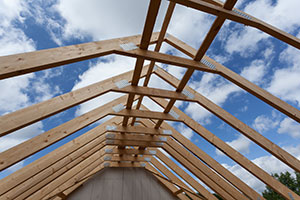Nick Boulton, chief executive of the Trussed Rafter Association (TRA), discusses the benefits of trussed rafters for housing associations.
With the Government pledging to build 1.5 million homes by 2022, the pressure is mounting on housing associations to deliver more social housing. The challenge is to deliver at high volumes while also maintaining quality.
Keeping Britain building throughout the uncertainty of Brexit, with an ongoing skills shortage, increasing costs and a need to ensure that new housing is sustainable, begs the question, how can this be delivered? The answer lies with Modern Methods of Construction (MMC).
Modern Methods of Construction
MMC it is a generic term used to embrace non-traditional and off-site approaches to the construction of new homes and is mooted as the solution to the UK’s housing crisis.
It ticks a lot of boxes including faster build time, improved quality, reduced costs, improved site efficiency, improved health and safety, less site wastage. It addresses the skills shortage too.
A definition framework was developed by the MHCLG Joint Industry Working Group on MMC to provide the industry with a clear understanding of what is classed as MMC. It also defines the full range of MMC used in the housebuilding industry with regulated terminology.
Trussed rafters, also known as roof trusses, provide a structural framework to support the roof fabric, ceilings or floors of buildings. They are a highly-engineered product manufactured offsite in factory-controlled conditions. Under the new framework, trussed rafters are  classed as Category 3, which is for pre-manufacturing components (non-systemised primary structure).
classed as Category 3, which is for pre-manufacturing components (non-systemised primary structure).
Speed and ease of construction
Delivering large volumes of social housing to meet increasing demand means finding a high-quality roofing solution that is also quick to install. Faster build times not only reduce the overall cost of labour but also mean that tenants can move in faster.
Trussed rafters lend themselves perfectly to this challenge, framing both simple and complex roofscapes in significantly reduced timescales. There should be no adjustments required on-site as the design will be manufactured with installation in mind. Roof features can be constructed at ground level before being craned into position, or they can be constructed at roof level as required.
Reduced costs
Like other MMC components, trussed rafters are manufactured in factory-controlled conditions to high production standards. They are individually tailored to the requirements of a project using the latest industry technology. This ensures that high standards of build quality are maintained, and waste and delays are kept to a minimum.
As the components are manufactured offsite ready for on-site installation, labour costs are significantly reduced. In addition, just-in-time delivery significantly reduces the risk of any pre-installation damage on site and means that there are no additional costs for storage.
The greener solution
With the climate crisis upon us and the Government committed to making the UK carbon neutral by 2050, the drive to find sustainable solutions for housing is gaining momentum. Trussed rafters are made from timber and engineered to minimise the materials required for a safe and effective roof structure, meaning significantly less environmental impact from their production.
When combined with timber frame construction and Passivhaus principles, trussed rafters can offer housing associations a blueprint for delivering high quality, sustainable housing that is low energy, and can also help to address fuel poverty amongst tenants.
While the challenges facing the social housing sector are tremendous, within the design and construction industry we have the knowledge and expertise to make a real difference.
As the voice of the trussed rafter and metal web joist industry in the UK and Ireland we are committed to stringent standards of quality and service and set a professional benchmark for the industry. To understand more please contact us or one of our members.
Find your nearest TRA member: www.tra.org.uk
- Log in to post comments













